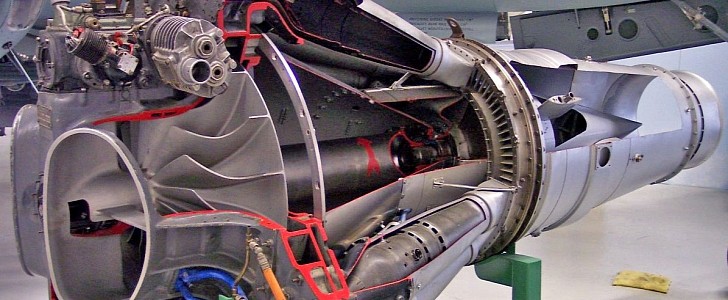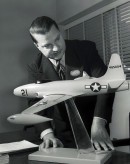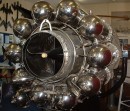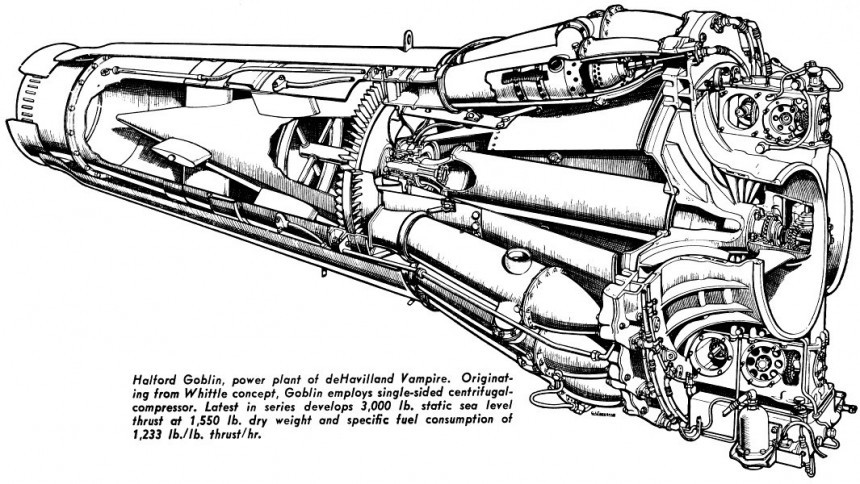There are a few misconceptions about the earliest history of the jet-engined fighter plane. It usually goes something along the lines of this. Firstly, there's a belief that the Germans were five to ten years more technologically advanced in its aviation than any Allied nation before 1945.
To a certain degree, this is very true. Spoils of war captured after the German capitulation in May 1945 showed German scientists were working on technology that made contemporary Allied weaponry look tame. Weapons like the V-1 flying bomb and Werhner Von Braun's V2 ballistic missile. But one item erroneously said to be completely in the hands of Germany during the war was the jet engine.
It can't be argued the Messerschmitt Me-262 was the first operational turbojet fighter airplane to enter service. Doing so in April 1944. But it would be flat wrong to assume jet technology was some marvel of entirely German origin. Depending on who you believe, the jet engine was conceived by one of two men, either Romanian national Henri Coanda with his 1910 ducted-fan biplane, or the British engineer Sir Frank Whittle.
Whittle's concept was fundamentally more related to what we would identify as the modern turbojet, as indicated by the patent for his most famous invention filed in 1932. By 1937, Whittle and his team devised a working prototype through his self-founded Power Jets Company alongside two of his old Royal Air Force buddies, in spite of getting stiffed on funding by the stuffy RAF top-brass several times.
It was a Power Jets W.2/500 that sent a Gloster E.28/39 experimental jet research aircraft to the skies in May 1941. Considering the Italian Caproni Campini N.1 motorjet had already flown by this point, it should be clear that the jet engine was far from Luftwaffe magic. Granted, the German Heinkel He 178 was the first turbojet airplane to fly in August 1939. But to say it took until 1945 for the Allies to get their hands on jet technology would be plainly false.
Fast forward to early 1944, and all the Allied nations were gearing up to bring operational jet fighters into service. Only one Allied jet would see service during the war, the British Gloster Meteor. But across the pond, the Americans were prepping their own fighter jet, the Lockheed XP-80 Shooting Star.
The development team was led by the aeronautical savant and underappreciated American hero Clarence "Kelly" Johnson. Whose other famous designs include the P-38 Lightning, the F-104 Starfighter, the U-2 Dragon Lady, and the SR-71 Blackbird. So to say, his team was the finest America had to offer.
Though it wasn't the first American jet fighter, that title belongs to the Bell P-59 Airacomet. The XP-80 was, on paper, the better performer by far. With a higher top speed, service altitude, and weapons platform, it wasn't even close. Part of this performance boost came yet again from a British turbojet. This time, it was the Halford H-1, or the De Havilland Goblin, as it was later known.
Oh, we should mention there were only two of these Goblin engines on the planet by this stage of 1944. So it should come as no surprise that when the first Goblin engine made its way to Lockheed's research facility, instructions were relayed along, saying something to the tune of "don't do anything stupid with our shiny new engine." So what do you think the Yanks did with it, then?
If your answer was to throw foreign objects at a fragile jet engine at full throttle during its very first startup, you'd be correct. Wouldn't you know, the compressor blades of one of the only working turbojet engines in the Western Hemisphere proceeded to shatter into thousands of pieces. Lockheed personnel were forced to call up the British to inform them of what had just happened.
In what must have been through gritted teeth and spiking blood pressure, the Brits agreed to send the second Goblin engine to the U.S. that'd only just finished production. The engine in question was only weeks away from being fitted to the first prototype of the De Haviland Vampire. In the end, the first Lockheed XP-80, dubbed Lulu-Belle, took off for the first time on January 8th, 1944.
Not quite in time for deployment in the Second World War, but in plenty of time to help form the backbone of the U.S. Air Force during the Korean War. Wouldn't you know, the production P-80's Allison J-35 engine was a copy of General Electric J-31, itself a copy of the engine in the British Meteor. And just like that, we've come full circle, folks.
It can't be argued the Messerschmitt Me-262 was the first operational turbojet fighter airplane to enter service. Doing so in April 1944. But it would be flat wrong to assume jet technology was some marvel of entirely German origin. Depending on who you believe, the jet engine was conceived by one of two men, either Romanian national Henri Coanda with his 1910 ducted-fan biplane, or the British engineer Sir Frank Whittle.
Whittle's concept was fundamentally more related to what we would identify as the modern turbojet, as indicated by the patent for his most famous invention filed in 1932. By 1937, Whittle and his team devised a working prototype through his self-founded Power Jets Company alongside two of his old Royal Air Force buddies, in spite of getting stiffed on funding by the stuffy RAF top-brass several times.
It was a Power Jets W.2/500 that sent a Gloster E.28/39 experimental jet research aircraft to the skies in May 1941. Considering the Italian Caproni Campini N.1 motorjet had already flown by this point, it should be clear that the jet engine was far from Luftwaffe magic. Granted, the German Heinkel He 178 was the first turbojet airplane to fly in August 1939. But to say it took until 1945 for the Allies to get their hands on jet technology would be plainly false.
The development team was led by the aeronautical savant and underappreciated American hero Clarence "Kelly" Johnson. Whose other famous designs include the P-38 Lightning, the F-104 Starfighter, the U-2 Dragon Lady, and the SR-71 Blackbird. So to say, his team was the finest America had to offer.
Though it wasn't the first American jet fighter, that title belongs to the Bell P-59 Airacomet. The XP-80 was, on paper, the better performer by far. With a higher top speed, service altitude, and weapons platform, it wasn't even close. Part of this performance boost came yet again from a British turbojet. This time, it was the Halford H-1, or the De Havilland Goblin, as it was later known.
Oh, we should mention there were only two of these Goblin engines on the planet by this stage of 1944. So it should come as no surprise that when the first Goblin engine made its way to Lockheed's research facility, instructions were relayed along, saying something to the tune of "don't do anything stupid with our shiny new engine." So what do you think the Yanks did with it, then?
In what must have been through gritted teeth and spiking blood pressure, the Brits agreed to send the second Goblin engine to the U.S. that'd only just finished production. The engine in question was only weeks away from being fitted to the first prototype of the De Haviland Vampire. In the end, the first Lockheed XP-80, dubbed Lulu-Belle, took off for the first time on January 8th, 1944.
Not quite in time for deployment in the Second World War, but in plenty of time to help form the backbone of the U.S. Air Force during the Korean War. Wouldn't you know, the production P-80's Allison J-35 engine was a copy of General Electric J-31, itself a copy of the engine in the British Meteor. And just like that, we've come full circle, folks.









